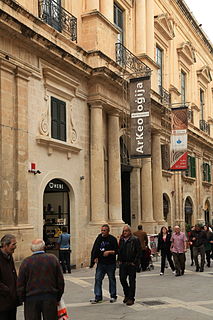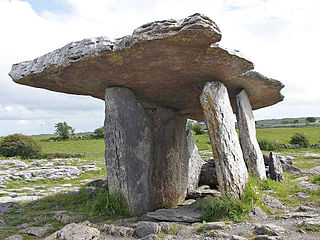The 31st century BC was a century which lasted from the year 3100 BC to 3001 BC.

Paola is a town in the South Eastern Region of Malta, with a population of 7,864 people. Paola is renowned for the Ħal Saflieni Hypogeum, its large parish church, its beautiful square with shopping centres, the Good Friday procession, and its football club, Hibernians FC. Mariam Al-Batool Mosque, the only mosque in Malta, as well as an Islamic Cultural Centre are found in Paola. The country's correctional facilities and the largest burial grounds, the Addolorata Cemetery are also in this town. The town is a commercial centre in the Southern Harbour area of Malta, about 5 km from the capital Valletta.

The Xagħra Stone Circle, also known as the Xagħra Hypogeum or the Brochtorff Circle, is a Neolithic funerary complex located in Xagħra, Gozo, Malta. It consists of a series of caves which were used to bury the dead, and which were surrounded by a walled enclosure. It mainly dates back to around 3000 to 2400 BC, although the earliest tombs at the site date back to 4100 to 3800 BC. The caves collapsed sometime before 2000 BC, and the site was later used for domestic and agricultural purposes.

Mnajdra is a megalithic temple complex found on the southern coast of the Mediterranean island of Malta. Mnajdra is approximately 500 metres from the Ħaġar Qim megalithic complex. Mnajdra was built around the fourth millennium BCE; the Megalithic Temples of Malta are among the most ancient religious sites on Earth, described by the World Heritage Sites committee as "unique architectural masterpieces." In 1992 UNESCO recognized the Mnajdra complex and four other Maltese megalithic structures as UNESCO World Heritage Sites. In 2009 work was completed on a protective tent.

The Megalithic Temples of Malta are several prehistoric temples, some of which are UNESCO World Heritage Sites, built during three distinct periods approximately between 3600 BC and 700 BC on the island country of Malta. They had been claimed as the oldest free-standing structures on Earth until the discovery of Göbekli Tepe. Archaeologists believe that these megalithic complexes are the result of local innovations in a process of cultural evolution. This led to the building of several temples of the Ġgantija phase, culminating in the large Tarxien temple complex, which remained in use until 2500 BC. After this date, the temple building culture disappeared.

Buġibba is a zone within St. Paul's Bay in the Northern Region, Malta. It is situated adjacent to Qawra, and it is a popular tourist resort, containing numerous hotels, restaurants, pubs, clubs, and a casino.
Tal-Barrani is an area in Malta located between the towns of Żejtun and Tarxien. The name defines an estate in the outskirts of a town or city, but can also be a reference to a foreign person or someone who is not a resident of the area.

The Skorba temples are megalithic remains on the northern edge of Żebbiegħ, in Malta, which have provided detailed and informative insight into the earliest periods of Malta's neolithic culture. The site was only excavated in the early 1960s, rather late in comparison to other megalithic sites, some of which had been studied since the early 19th century. The site's importance has led to its listing as a UNESCO World Heritage Site, a listing it shares with six other megalithic temples in Malta.
The Saflieni phase is one of the eleven phases of Maltese prehistory, the fourth of five in the middle or Temple period. It is named for the Ħal-Saflieni Hypogeum, an underground temple complex now recognised as a World Heritage Site by UNESCO, which was built mainly in this period.
The Mġarr phase is one of the eleven phases of Maltese prehistory. It is named for the town of Mġarr, in the west of the island, where pottery older than the Ta' Ħaġrat temple complex was found.

The National Museum of Archaeology is a Maltese museum of prehistoric artifacts, located in Valletta. It is managed by Heritage Malta.

Borġ in-Nadur is an archaeological site located in open fields overlooking St George's Bay, near Birżebbuġa, Malta. It is occupied by a Tarxien phase megalithic temple as well as the remains of a Bronze Age village which includes the earliest fortification in Malta. The site is located close to various Bronze Age cart ruts and silos, as well as Saint George Redoubt which was built thousands of years later in 1715–1716.

Ta' Ċenċ Cliffs is a 20 ha linear strip of cliffed coastline at Sannat, on the southern coast of the island of Gozo, Malta, in the Mediterranean Sea. The area consists of garrigue and steep and rugged cliffs, which rise from sea level to a height of 120 m. The cliffs are identified as an Important Bird Area (IBA) by BirdLife International because they support 800–1000 breeding pairs of Cory's shearwaters and 150–300 pairs of yelkouan shearwaters.

Tal-Qadi Temple is a megalithic temple in Salina, limits of Naxxar, Malta. It is in a very bad state of preservation, with only the temple's general outline still visible.

Santa Verna is a megalithic site in Xagħra on the island of Gozo, Malta. The site was originally occupied by a village and a megalithic temple. Although the temple is in poor condition now, in ancient times it was probably one of the major temples in the Maltese islands. The site takes its name from a chapel dedicated to Saint Venera that once stood close to the temple.

Buġibba Temple is a megalithic temple on the border of Buġibba and Qawra towns, limits of St. Paul's Bay, Malta. It is located in the grounds of the Dolmen Resort Hotel.
The Kordin Temples are a group of megalithic temples on Corradino Heights in Paola, Malta. The temples were inhabited from pre-history, by Phoenicians and then by the Greeks and Roman periods. In the 17th century the site belonged to Giovanni Francesco Abela. He had excavated several sites in the whereabouts, and had his country residence in the area. He had originally planned to write his will to the Order, but eventually left his villa, that was used as Malta's first museum, known as Museo di San Giacomo, and the surrounding lands to the Jesuits. The land still belonged to the Jesuits, until their expulsion in the 18th century by the Order when all their land and property was taken by the treasury. The site was escavated during the Order of St. John on the order of Grand Master Manuel Pinto da Fonseca by archeologist Gio Antonio Barbaro. The temples were then extensively excavated by Sir Themistocles Zammit during the British period.














